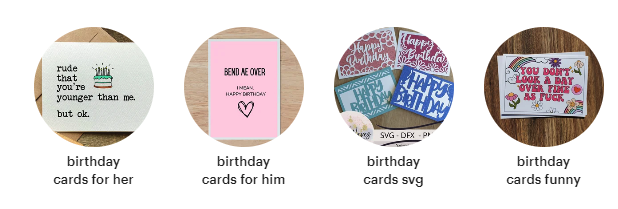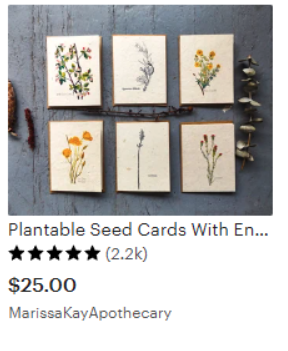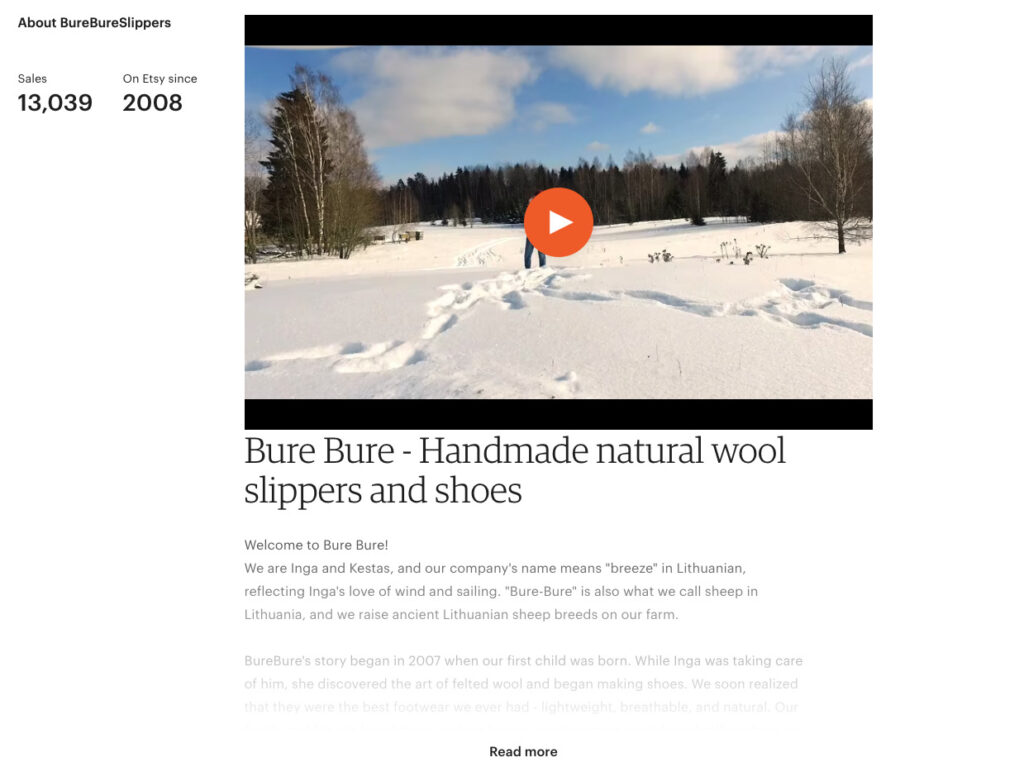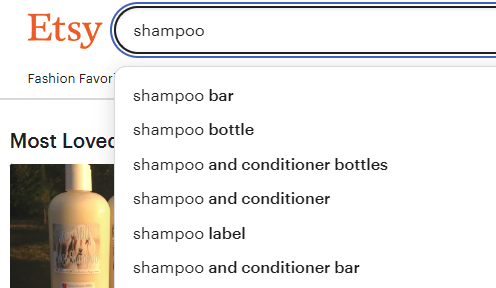Etsy SEO: How to rank higher and increase your store’s revenue
By Kaleigh Moore July 11, 2023
Etsy is one of the prettiest marketplaces on the Internet, and your store is part of it. You’ve set up fantastic products for sale, captured them with eye-catching photographs, and you’re open for business.
There’s just one critical element missing from this pretty picture.
Customers.
Here’s the dirty little secret about Etsy: 50% of the traffic comes from direct links outside the website. People with popular shops are drawing all the attention. This has a cascade effect: the rich are getting richer.
That leaves fierce competition for the other 50%—and SEO that’s tough to crack.
Etsy isn’t Google; it’s got its own set of rules to follow. Fortunately, Etsy’s SEO policies aren’t only intuitive and customer-friendly: they’re also transparent. Etsy’s happy to tell you what’s important so you can boost your new store’s ranking.
Let’s explore what that means. From tags to titles, here are the best Etsy-friendly tactics to position your store for maximum traffic.
Etsy SEO: What You Need to Know
Even if 50% of Etsy traffic comes from outside sources, the other 50% is nothing to sneeze at. There are over 450 million visitors on Etsy every month.
Capturing the attention of those visitors is a matter of playing by Etsy’s SEO rules. The better you play, the more likely it is you’ll get prominent placement.
Let’s explore the Etsy SEO tips that will move the needle.:
CSR (Context Specific Ranking): What is SEO on Etsy?
Etsy SEO isn’t like every search engine you’ve come across. Yes, Etsy will tell you they want to match a relevant customer query with the right product. But there’s one other element that plays a huge part in the equation.
Your performance.
Think less Google, and more Amazon. When you visit Etsy and enter a query—say, for “women’s shoes”—you’ll see something that looks like this:

Notice something?
Each listing is 1) popular, with tons of reviews in its history, and 2) well-reviewed at least four-and-a-half stars.
The performance of your shop will play heavily into your rankings. This is a “rich-get-richer” equation. The more conversions you generate, the more conversion opportunities Etsy will send you.
But let’s back up. How does Etsy determine how “good” a product listing is, especially given a specific search term?
It’s called CSR, or “context-specific rankings.”
Let’s explore the individual elements you can use to build up your CSR.
Query matching
Every Etsy search begins with a query. The buyer enters in what they want—let’s say “birthday cards”—and the store kicks off a chain reaction.
Here’s how Etsy puts it:
We look at the titles, tags, listing descriptions, categories, and attributes you’ve added to find matching keywords. Using all 13 tags, adding variety to your tags, adding all the relevant attribute options, and categorizing your items as specifically as you can may all help increase the chance that your listings will match with a query.
Your first goal should be relevance. Don’t try to sell “cards” to everyone. Create a product-specific page for “birthday cards.”
The more specific, the better. Look what Etsy suggests:

Every iteration of a query is a unique opportunity to be a precise query match for your audience. So before you think you’ve failed at Etsy, keep this in mind: you need to create specific products for as specific a query as you can imagine.
Otherwise, you’ll always be competing with the highest-ranking products.
Relevancy
Think of relevancy as an offshoot of query matching. The most valuable link for a search query should make the customer think: “Yes, that’s exactly what I was looking for!”
Why is specificity so important? Because it means you can aim all of your Etsy keywords at the same concept, pumping up your relevancy rating. That means:
Tags
Find tags under Shop Manager > Listings and click the item you want to tag. Once you select “edit,” you’ll find tags toward the bottom of the listing details.
Tags are raw information, so you don’t need to gussy these up for advertising purposes. Simply insert the bare-bones keywords that best describe your product, starting with the most relevant target keyword first.
Titles

Your titles are equivalent to your headlines, if you were creating a blog post you wanted to show up in Google listings. They should start with the keyword (above: “Plantable seed cards”) but also feature a brief description of what customers can expect.
Ideally, a good Etsy title balances writing for SEO and descriptiveness for the users. Specificity and clarity in your headlines will serve both.
Listing Descriptions
Though descriptions target customers more than search engines, they’re still a key point for matching query relevance. To create an effective listing description:
- Start with the relevant keyword. Don’t say: “You will enjoy this snarky birthday card!” Instead, lead with the keyword: “Snarky birthday card | perfect for fathers and older brothers.”
- Add your creativity later in the description. Remember, Etsy users are scanning a shop, not reading your novel. If you want to get more vivid and descriptive, make sure you do it after you keep the keywords.
Don’t ignore descriptions. You haven’t finished your “How to improve my Etsy SEO” checklist until you’ve taken full advantage of every keyword opportunity you have.
Categories
Etsy’s categories tie closely with its query matching. In fact, you can even use Etsy’s category directory for ideas on product iteration, SEO, and keywords.
You may quickly run into the limit. For example, if your goal was “snarky birthday card,” you’ll notice Etsy’s categories only drill down from Greeting Cards -> Birthday Cards. But consider the categories a good jumping-off point to position your products effectively.
Attributes
Attributes are product-specific delineators that won’t be relevant across categories. T-shirt attributes like “XL tall” won’t make sense if you put them on moccasins.
Etsy likes specific attributes because they help the platform respond with more relevant listings for its users. A customer might want a sweatshirt in a medium size, for example. Etsy would prefer not to show products for Big & Tall listings instead.
Want one of our best Etsy SEO tips? Don’t try to appeal to everyone. You should aim to provide maximum appeal for one customer who’s on a mission to find your product.
Listing quality score
If you’ve optimized the above, great. But you’re not there yet. Etsy uses a listing quality score to determine a critical factor: is your product pleasing customers?
If not, Etsy would prefer to highlight the products which are pleasing customers. Elements like customer rating, how often your product gets a “favorite” or even a purchase, and pricing all factor in here.

Your goal with SEO for Etsy, then, is to aim for narrow quality. This product page has to be the answer to customers’ queries.
If you want quantity, you’ll have to keep creating new product pages—each with an eye on providing that same customer-pleasing quality at every turn.
Recency
Have you started an Etsy store and seen initial success? Then, later, you wonder why Etsy seemed to “ding” you back down to Earth?
It’s not you. That’s how Etsy’s recency bias works: it rewards new listings, giving them what Etsy calls a “small, temporary boost in search results.”
Etsy’s goal is to learn how customers will react to it. By sending you traffic, they’re gathering sample data. How well you can convert browsers into buyers during this “trial period”?
It lasts either a few hours or a few days, so make sure you have your ducks in a row before you launch. Don’t launch first, then optimize. When it’s time to activate a new listing, everything on this list should be optimized and ready for action.
It’s worth noting here that Etsy doesn’t recommend renewing items or creating new listings as a strategy. It’s better to have a successful product page that continuously converts customers rather than game the system.
Customer and market experience
Once Etsy rates your customer and market experience score, it factors into how well your products fare on its search engine. According to Etsy, you’ll want to focus on three key factors here:
- Great reviews. Product quality, shipping experience, and how responsive you were all factor into the kinds of reviews your customers will write you. Treat each review like it’s worth its weight in gold.
- Complete shop policies. Accurate, comprehensive shop policies help you manage customer expectations, which factor into the quality of your reviews.
- A well-written “About” section. Etsy About Us sections are opportunities to tell stories, set more customer expectations, and inspire loyalty for your shop—which can fuel future conversions.
If you want to see a live sample of an effective About Us section, check out BureBureSlippers and look at the elements it contains.

They tell a brand story, they explain what comes in every package (setting customer expectations), and they provide links where customers can find them on social media. Include those three elements and you’ll be ahead of the game.
Shipping Price
There’s no getting around it: customers love free shipping.
Etsy says that its buyers tell them that shipping price is one of the most important factors driving purchases. Since your goal in SEO is to convert as many purchases as possible, a low shipping price is the fastest way to “buy” a customer’s love.
Here’s what Etsy says to do:
- If possible, create listings that ship for free to the U.S.—there are few offers as compelling as “free shipping”
- Add a free shipping guarantee, which gives you priority U.S. search placement in the Etsy app
If you offer that to customers, Etsy wants to offer your store to customers. That’s how it pleases people.
Shoppers’ previous habits
Finally, there’s one element you should consider, but not always try to control: a shopper’s previous buying habits.
Etsy will rank products according to the shopper’s tastes and preferences. This means you may do everything right and still get a ding from Etsy SEO, depending on the customer.
But it can also work in your favor.
If you think about your ideal shopper profile and cater your shop around them, you can use this element of Etsy shopping to corner your niche. That takes trial and error, but it’s how many Etsy shops find success despite selling rare and unique items.
Keywords on Etsy: finding your target market
Now that you know what to do, it’s time to get specific to your product. That means selecting the ideal keyword to target.
Once you have your keyword, you’ll want to give it prime placement everywhere you can:
- Tags
- Titles
- Listing descriptions
- “About Us” section, if relevant
- Categories
- Attributes, if relevant
But let’s rewind. How do you know you’ve selected the right keyword in the first place?
Researching your Etsy keywords
Head over to Etsy’s product categories to see where you’ll fit. If you can’t find a relevant category, it’s a sign you need to make your product more accessible.
For example, let’s say you sell homemade shampoos. Do a Control + F search for “shampoos” and you’ll land under:
Bath & Beauty -> Hair Care -> Shampoos
But don’t stop there. Shampoos are still a broad category. Head to Etsy search and type in your category to see what’s already selling.
Like Google, Etsy will autosuggest similar terms. Now you’ve got more “categories,” even if they’re not official categories listed on Etsy.

Enter a few of those searches, and you’ll see even more specific keywords you can target. Drill down until you have a match between your precise product and what appears to be a popular enough key phrase—but still a highly specific one.
According to Etsy, “categories act like tags.” Choose yours carefully. Remember that if you have a category like “shampoo,” you may also show up in hair care and health & beauty searches.
Check out the competition
It never hurts to find out what’s already working on Etsy. This is especially useful since you can copycat many of the same strategies.
As long as your product page gets enough conversions, you’ll have a high-quality score.
Should you directly copy what other products are doing? No; that will impact how customers view you. But you can look at how they’re implementing their strategies to hone yours.
Ask yourself:
- What keywords are they highlighting, and how are they highlighting them? Which are the keywords that show up most often in descriptions, titles, and tags?
- Can you find categories where there are plenty of competitive products, but not specifically targeted keywords? These are rare opportunities where you can position yourself by aiming for that keyword.
Writing creative titles with keywords in them
Your goal with Etsy SEO: please people, not robots.
Etsy says that a title like “Personalized dopp kit men’s leather dopp kit groomsmen gift add a monogram” isn’t written for people. Since SEO for Etsy is about getting more conversions to improve your listing, write with people in mind first.
One strategy you can use: “split” the key phrase, as this listing does.
Porch Decor Oh Hello Doormat | spring doormat | hand lettered doormat | cute doormat | outdoor doormat | wedding gift | housewarming gift
Notice that the first keyphrase is readable. Porch decor, “Oh Hello” doormat. Yes, it’s stuffed with keywords, but it uses “|” symbols to guide you visually.
Customers scanning for “porch decor” will know exactly what they’re looking at.
You may be tempted to show off your creativity here, but keep in mind you’re writing for shoppers, not readers. If they want to read about your product, they’ll click on the product page.
A good title is keyword-dense, written for scanning shoppers, but not so keyword-intensive that it’s incomprehensible to the humans you’re trying to sell to.
Attributions on Etsy: boosting your visibility
One of the most overlooked aspects of Etsy SEO are those pesky things called attributes.
If you remember earlier, attributes are specialized information tags, only relevant to a particular product category. Let’s explore a few examples:
- Earrings have attributes like “ear location.” Conch? Cartilage? Earlobe?
- Shirts have attributes like sleeve and collar style. Banded collar? Spread collar? Turtle neck?
- Wall decor has attributes like frame style. Canvas? Wood frame? Metal frame? Print?
These might seem like minute details. But if you’re an Etsy shopper with a specific product in mind, you might type these exact attributes into the search bar.
This means that the more attributes you carry, the better your Etsy SEO.
It’s counterintuitive, but the more specific you are about what product you’re selling, the more you can expand your audience.
A customer who finds their exact attributes on your Etsy page is more likely to convert—either by clicking “favorite” or ordering your product.
This, in turn, drives up your quality score, boosting your product placement. The higher the placement, the more customers see your products, and so on.
This is why it’s better to be thorough with how you create your products. Don’t create one universal listing for your entire store. Drill down, product by product, until each product page serves its ideal customer.
Improving your Etsy ratings for better SEO
Now that you know how to plant your flag on Etsy, what are some things you can do to get more views on the platform? Let’s move beyond keywords and focus on those all-important conversions.
Listing quality
According to Etsy, there are three criteria that determine the quality of your latest product listing:
- Clicks. First things first: is your listing attractive enough to turn a searcher into a clicker? This is the first portion of the funnel: your product’s ability to stand out in a sea of product images and descriptions.
- Favorites. A customer might “favorite” your item for possible later purchase. Or they may simply want to bookmark it. Either way, Etsy views this as a sort of mini-conversion—it means they liked your listing, they just didn’t buy yet.
- Purchases. Of course, the ultimate gauge of how good your listing looks is whether a customer puts their money where their clicks are.
Every small interaction, even clicking “favorite,” becomes a conversion for your Etsy product. You don’t always have to make the sale. You just need to entice people to think about it.
So what determines whether you’ll get these conversions?
- Picture quality, especially the first picture. We’re visual creatures, after all—and so are Etsy shoppers. If you have well-lit, professional product photos, you’ll generally beat the listings that don’t.
- Listing title. This is particularly important if you can nail exactly what your customers searched for.
- Offers. Do you offer a free shipping sale? Etsy’s customers love free shipping. They may even consider your product over one they prefer when they see you’re offering free shipping.
- Reviews. Obviously, the higher the better. And that has fun implications for everything you do in your Etsy business. Great customer service will always impact Etsy SEO. So have fun! Go the extra mile for customers—leave them personalized notes, give them little extras, and be responsive with your customer support. You won’t only earn a better reputation; you’ll get preferential rankings in your search terms.
Make full use of Etsy’s SEO offerings
Etsy gives you plenty of avenues to build a shop’s popularity from scratch:
- Use all 13 possible keyword tags for every product you have; there’s no reason to ever stick with 12 when you can maximize your chances.
- Dial down your product listings to the most specific categories. If you don’t get clicks or conversions because you list your product in huge categories, it will hurt your conversions, driving down your SEO quality.
- When all else fails, offer free shipping to create a boost in your score.
- Create a full “About Us” section featuring your story, the products you offer, what every customer receives with a shipment, and any relevant social links.
- List your shop policies—at the very least, it establishes expectations for customers which enhances your chance at a good review.
- Check your Etsy analytics to see where you’re coming up short. Then give your listings a once-over to see what’s missing. Look for traffic volume, sure, but especially pay attention to conversions. If your conversions are low, you don’t need to add more products; you need better listings for your current products.
Keeping the traffic you gain on Etsy
Done well, Etsy SEO optimization is a new engine driving traffic to your business. This means you can capture Etsy customers into your newsletter pipeline.
Of course, Etsy has a strict Seller Policy—people have to be able to opt into the lists they join. Any Etsy seller sending emails with AWeber automatically adheres to this policy.
AWeber also has an additional tool to drive more traffic: an automated newsletter blast that triggers when you publish a new Etsy product to your store. This helps you capitalize on the short-term Etsy boost, driving more conversions from your most loyal customers and reinforcing your prime SEO placement.
From rock-bottom to prime placement on Etsy
Etsy SEO isn’t always intuitive. But as long as you remember it’s a customer-pleasing game, you’ll have a rule of thumb to fall back on: make customers happy.
And if you can get those numbers up, you can start specific and build a big store up from a “neutral” rating. It doesn’t hurt to use AWeber to build your reputation online so you aren’t only selling on Etsy, but capturing an audience that goes beyond just one platform.
Consider integrating Etsy with AWeber. You’ll be able to send out to your list every time you create a new Etsy product. And if you don’t have an AWeber account, don’t forget it’s free to sign up.
 87% off ends soon!
87% off ends soon! 
